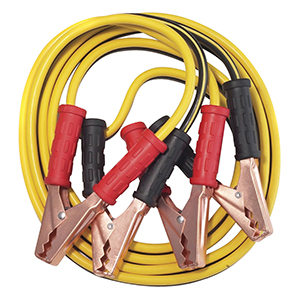A booster pack, jump starter, or jump box is another common piece of equipment used to jumpstart car batteries. Unlike jumper cables, a booster pack doesn’t need a second battery to work. This eliminates your need to wait for a Good Samaritan to pass by and offer their vehicle to connect to your jumper cables. A booster pack can bring your battery back to life all on its own.
Booster packs can also determine if the polarity of their cables is incorrect. If this happens, the pack won’t deliver any power until the connections are corrected. Jumper cables can’t do this, and you can do a lot of damage to your vehicle if you attempt to jumpstart it when the connections are crossed.
Most booster packs don’t weigh more than 10 kg, but they’re powerful enough to start a V8 engine. They’re incredibly compact, with some being small enough to fit in your pocket.
Booster packs can be used for more than just car batteries. Many come with power sockets, USB charging ports, air compressors, or emergency lighting, making them a multi-purpose tool.
The main disadvantage to a booster pack is you need to manually charge it. If you forget to recharge the pack between uses, it may be dead the next time you need it. Charge the pack at least every two or three months. If your car has a 12 V socket, you can hook up your booster pack to it and charge it while you drive.
Check out this article for more tips on how to get the most out of your booster pack, and this one for how to use one.








I know this is stupid but I have to ask:
Is there a device that can be left attached under the hood that would ensure a reliable start in cold weather every time?
And:
Is there a reliable block heater I can have installed in my 2005 Nissan Xtrail that will actually do a better than average job?
As you can guess my older vehicle is just not starting properly with the -38°Celsius weather, even though it is always plugged in wham it is -15°Celsius or colder. This past week I cannot start it at all and I have a newer 5 year battery in it since last winter which was installed by AMA road assistance. Last year only boosting it could get it started, but at least it worked. I finally decided to get a new battery then… The fix last year is not working this year though, even with the newer battery.
My vehicle is never ever EVER(!) warm enough to feel comfortable while driving but up until this latest cold snap I have always been able to start it without any issues. I need help and advice. Thanks to anyone who can assist.
Hi Sandra,
I suggest you to read this article about block heaters: https://blog.napacanada.com/en/how-to-use-a-block-heater-to-survive-the-winter/
Hope it’ll answer your question!
Eloïse Dussault | NAPA Canada
When you say it occurred last year as well, was that during the colder weather as well? It MAY be a starter if it occurs fairly consistently. Possibly loose battery connection? Possible corrosion on battery terminal/clamps and/or inside battery cables?
If it only occurs in colder temperatures, try switching to full synthetic engine oil first to see if that makes any difference. Also ensure your block heater is working. Having your block heater on for 3 hours prior to starting in cold weather should be sufficient. The block heater itself may be defective, the extension cord, the electrical receptacle or the breaker for that receptacle may be tripped. Last year I had to re-wire my electrical receptacle I use for my block heater so it was on it’s own circuit as it kept tripping the breaker due to the pad of the block heater. Weird though that that breaker had never tripped the previous 18 years I used it for the block heater.
Hi Sandra,
I forgot to add. I do not think there is anything you can leave attached under the hood to ensure a more reliable cold start other than perhaps a battery blanket to cover your battery, assuming the battery is the issue here. A battery blanket sure wouldn’t hurt though either way.
Yes, there is. NAPA sells a charger, part number MBC 90300A, that is designed to be mounted under hood, where there’s room, and can be plugged in at the same time as your block heater. I have used one for years, and it is far better than a block heater alone.
I blog quite often and I genuinely thank you for your information. This great article has truly peaked my interest. I am going to take a note of your website and keep checking for new information about once a week. I opted in for your RSS feed as well.